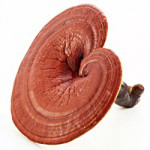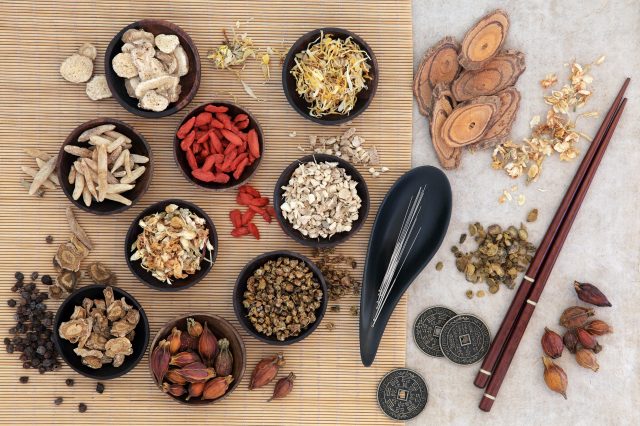Shop News
-
25/11/2025Ganoderma Benefits
-
07/02/2025Colds & Flu - treatment and prevention
-
24/01/2025Ginseng - Nature's anti-inflammatory
-
23/01/2025Curcumin Benefits
-
02/05/2024Allergies Tradicional Chinese Medicine
-
12/03/2024Food Combining and Chinese Medicine
-
23/08/2023Phytoestrogens
-
05/06/2023Ginseng Benefits
-
02/06/2023Aumento de precios de la marca Blue Poppy
-
20/07/2022Infertility and Chinese Medicine
-
10/05/2022Allergic Rhinitis
-
24/03/2022TCM Obesity and Its Causes
-
23/03/2022Cancer Prevention and Diet
-
26/01/2022Medicinal Mushrooms
-
18/12/2021Christmas Remedies
-
09/07/2021CANDIDIASIS
-
03/03/2021Chinese Herbal Medicine formula studied to improve cancer therapy
-
12/01/2021The benefits of Xiao Yao San
-
15/09/2020Coronavirus Protocol (summary)
-
01/06/2020TCM Principles for Weight Loss
-
12/02/2020Take Good Care of Your Qi
-
01/01/2020Cordyceps Sinensis Benefits
-
01/12/2019Prevention & Treatment of Colds & Flu
-
27/04/2019ANXIETY - causes and treatments
-
26/03/2019Prostatitis and Chinese Herbs
-
01/03/2019What is an Adaptogenic Herb?
-
05/02/2019New Jade Herbal Formulas
-
09/12/2018The Shen of the Heart
-
23/08/2018Hyperthyroidism and Hypothyroidism
-
05/07/2018FOCUS ON A REMEDY: WARM THE MENSES
-
04/04/2018Treating Insomnia With Chinese Herbal Medicine
-
25/03/2018Cordyceps Sinensis research
-
01/03/2018Chinese Herbal Medicine for Panic Attacks
-
17/01/2018Clinical application of the Clear Metal remedy for advanced stage of influenza
-
02/01/2018New Pediatric Formulas by "Blue Poppy"
-
07/11/2017BI SYNDROME
-
01/09/2017Chemotherapy and Anti-Oxidants
-
05/03/2017Lumbar Disc Herniation
-
31/01/2017Treatment Principles in Exterior Invasions
-
21/10/2016Healthy Aging and Oriental Medicine: Qi is the secret
-
23/09/2016Horny Goat's Weed Benefits
-
23/07/2016FOCUS ON A REMEDY: PROSPEROUS EARTH
-
25/06/2016Ginkgo Biloba Benefits
-
23/03/2016Blood Stasis
-
23/02/2016FOCUS ON A REMEDY: PROSPEROUS EARTH
-
23/01/2016CHRONIC FATIGUE SYNDROME
-
28/12/2015TONICS
-
24/10/2015A CASE HISTORY OF CHRONIC BRONCHITIS
-
23/09/2015Ganoderma Lucidum reduces obesity in mice
-
01/07/2015The Five Elements and Diet in Chinese Medicine
-
23/05/2015Daoist Sexual Practices
-
21/02/2015DEPRESSION
-
22/01/2015GLAUCOMA
-
20/12/2014ENDOMETRIOSIS
-
28/11/2014POLYCYSTIC OVARY SYNDROME
-
21/08/2014Ear infections and antibiotics
-
24/06/2014FOCUS ON A REMEDY: CHEMO-SUPPORT
-
21/03/2014Stomach-Yin Deficiency and Jade Spring
-
21/02/2014JOY, AN EMOTIONAL CAUSE OF DISEASE?
-
17/01/2014SEXUAL LIFE IN CHINESE MEDICINE
-
19/12/2013ON STAGNATION OF LUNG- AND HEART-QI
-
14/11/2013THREE TREASURES REMEDIES FOR PAIN
-
23/10/2013HEADACHE CASE HISTORY
-
22/10/2013.
-
12/07/2013Giovanni Maciocia Clinical Tip: Arouse Power
-
28/05/2013Blue Poppy - New Formulas
-
19/04/2013Case history - Chronic constipation
-
14/03/2013Three Treasures Webinar
-
31/01/2013Recurrent Bronchitis: a case history
-
31/12/2012FOCUS ON A REMEDY: SOOTHE THE SHEN
-
18/06/2012Herbs for the treatment of Anorexia
-
09/05/2012Three Treasures & Women's Treasures now available
-
09/04/2012REMEDY OF THE MONTH: CLEAR YANG
-
02/07/2011New Pediatric Formulas
-
28/04/2011Lingzhi slows progress of Alzheimer’s
-
18/10/2010European Legislation for natural products
-
19/09/2010700-year-old Chinese medicine can treat depression...
-
24/04/2010PDF Catalog
-
01/09/2009Swine Flue
Ganoderma Benefits
Ganoderma is not often used in cooking because they are hard and have a bitter taste, although some people do use them in the same dishes that you might use Shiitake mushrooms (Lentinula edodes). But you are unlikely to find them at your favorite market. They are mainly used for purely medicinal purposes and have a number of health benefits. In fact, it is known among practitioners of Chinese medicine as the “king of herbs.”
All mushrooms are the “fruit” of fungi as well as the reproductive part. Ganoderma can be found growing up from underground networks called mycelium near organic waste and logs, which are both a good nutrient source. Given the right conditions, Ganoderma can actually be cultivated and used in medicine.
The Eastern world has been using Ganoderma for thousands of years, particularly in China and Japan. Even the ancient kings and emperors drank reishi tea because it was believed that its properties encouraged vigor and long life. They also thought that the tea would increase their wisdom and happiness.
The use of reishi has reached the Western world where these days people are making elixirs from the mushroom for the purpose of promoting vitality and longevity. It is also used to treat certain medical conditions.
Benefits of Ganoderma and Supplements
The benefits of Ganoderma are so well known and proven that you can get them in forms that are much convenient that slicing them up and cooking with them. You can buy them dried, in concentrated tablets, capsules, or even as an extract. In any of these forms Ganoderma can be used as a dietary supplement.
Here is a list of the benefits that Ganoderma have as a daily dietary supplement or in helping to treat certain medical conditions:
· These mushrooms are very strong antioxidants. Antioxidants protect the body from the negative effects of free radicals that are formed inside the body by daily exposure to the sun, chemicals, and pollutants. Ganoderma are proven to boost the immune system, especially when taken with other antioxidant supplements.
· It is believed that Ganoderma can suppress the growth of tumors in people with cancer. It can reinforce the membranes in cancerous cells to keep the tumor from spreading. For this reason, they are often used in efforts to prevent cancers.
· Ganoderma are also beneficial for people suffering from asthma and other respiratory conditions because it seems to have a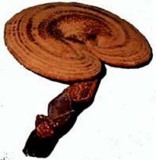 healing effect on the lungs. They are good for building respiratory strength and curbing a cough.
healing effect on the lungs. They are good for building respiratory strength and curbing a cough.
· Ganoderma have anti-inflammatory properties and are therefore used sometimes for patients who have Alzheimer’s and heart disease. This is based on the idea that inflammation plays a part in each of these conditions. The pain that accompanies other inflammatory conditions like neuralgia and arthritis may also be lessened by Ganoderma supplements.
· As far as benefits for the heart, Ganoderma can improve the flow of blood to the heart and reduce the amount of oxygen the heart consumes. It can help to lower cholesterol and some of the ingredients may help combat high blood pressure.
Ingredients in Ganoderma
So exactly what is in Ganoderma that give it so many health benefits? Scientists have learned one active ingredient is polysaccharides, which contain beta glucan. Beta glucan is known for its ability to enhance the immune system – in fact it is one of the strongest immune system supplements there is.
Another ingredient in Ganoderma is triterpenes. The type found in Ganoderma is a ganoderic acid that has been proven in studies to ease the symptoms of allergies by stopping the release of histamines. It also can improve the body’s use of oxygen and help the liver function better.
Colds & Flu - treatment and prevention
Colds & Flu - treatment and prevention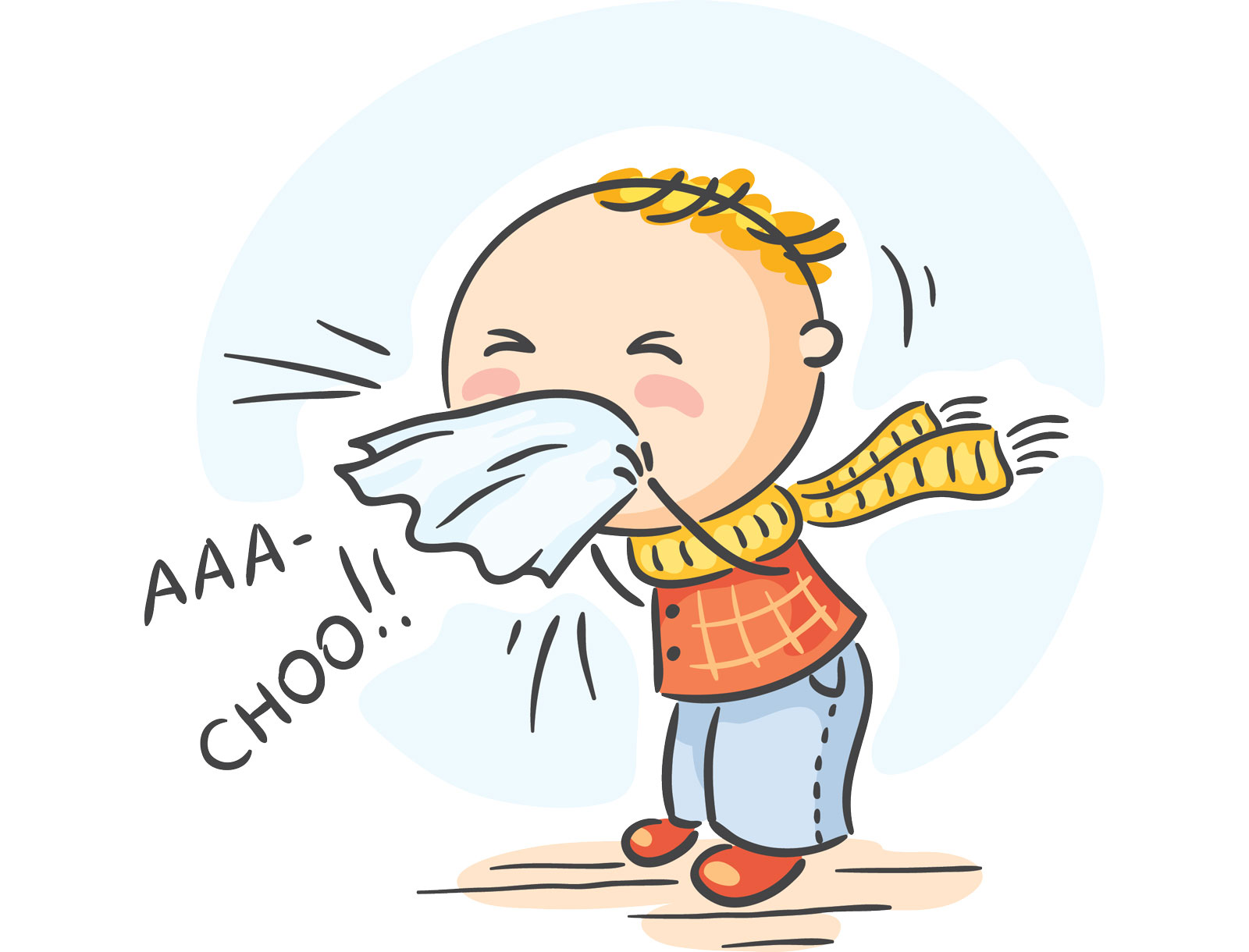
Today we receive mixed signals from doctors about how to treat common colds and flu. The fear of widespread antibiotic resistance has many people avoiding the doctor altogether when they get sick. Left with over the counter medicines to treat symptoms so that we may continue working or school, it often can take up to two weeks for a cold to resolve. Chinese herbs and Acupuncture can be a valuable resource in the prevention of colds and flu and can also help us recover from them quickly and easily.
Prevention
It is possible to use Chinese medicine to prevent the infections of colds and flu altogether or when caught early, to prevent them from turning into full-blown infections. Studies have shown that certain acupuncture points are effective in boosting the immune system. Herbal medicine can be prescribed to enhance your immune system. When people around you are getting sick, taking preventive herbs will increase your ability to fight off illness and remain healthy.
Prevention formulas:
Yu Ping Feng San: https://www.eqilibrium.net/en/yu-ping-feng-san.html
Astragalus: https://www.eqilibrium.net/en/astragalus-membraneceus-huang-qi.html
Five Mushroom Formula: https://www.eqilibrium.net/en/five-mushroom-formula-peoples-herbs.html
Ganoderma: https://www.eqilibrium.net/en/ganoderma-lucidum-seta-lingzhi-reishi.html
Panax Ginseng: https://www.eqilibrium.net/en/ginseng-ren-shen-pian.html
Cordyceps: https://www.eqilibrium.net/en/empowered-cordyceps-sinensis-mycelium.html
Treatment
If you do happen to catch a cold or the flu, Chinese herbs can help lessen the severity and speed the recovery time of illness. If you take action at the first signs of a cold or flu, such as sore throat, earache, fatigue or body aches, herbal medicine will help to relieve symptoms and repair your immunity so that your body can fight off the infection.
Commonly used flue and cold treatment formulas:
Yin Qiao San: https://www.eqilibrium.net/en/yin-qiao-san-pian.html /
https://www.eqilibrium.net/en/yin-qiao-san-blue-poppy.html
Herbal Sentinel Yang: https://www.eqilibrium.net/en/herbal-sentinel-yang-giovanni-maciocia.html
Herbal Sentinel Yin: https://www.eqilibrium.net/en/herbal-sentinel-yin-giovanni-maciocia.html
Expel Wind Heat: https://www.eqilibrium.net/en/expel-wind-heat-giovanni-maciocia.html
Qing Qi Hua Tan Tang: https://www.eqilibrium.net/en/qing-qi-hua-tan-tang-blue-poppy.html
Xiao Chai Hu Tang: https://www.eqilibrium.net/en/xiao-chai-hu-tang-blue-poppy.html
Recovery
It is common knowledge in Chinese medicine that it is possible to recover from an illness and be stronger for it. Using acupuncture and Chinese herbs during the recovery stage of infection is a good way to ensure you are completely over the infection and that your immune system is intact and ready to fight off the next bout of sickness that makes its way through your home or work environment. Symptoms like lingering cough or phlegm or an irregularity in your elimination are common complaints after a severe bout with the flu.
Recovery formulas:
Immortal Qi: https://www.eqilibrium.net/en/immortal-qi-blue-poppy.html
Shi Quan Da Bu Tang: https://www.eqilibrium.net/en/shi-quan-da-bu-tang-blue-poppy.html
Er Chen Tang: https://www.eqilibrium.net/en/er-chen-tang-blue-poppy.html
Ganoderma Lucidum: https://www.eqilibrium.net/en/ganoderma-lucidum-seta-lingzhi-reishi-en.html
Cordyceps: https://www.eqilibrium.net/en/empowered-cordyceps-sinensis-mycelium.html
Five Mushroom Formula: https://www.eqilibrium.net/en/five-mushroom-formula-peoples-herbs.html
Liu Wei Di Huang Wan: https://www.eqilibrium.net/en/liu-wei-di-huang-wan-blue-poppy.html
The Benefits of an Alternative
Chinese medicine was developed to treat many different illnesses, but made particular advancements in its medical history when doctors began to look specifically at the treatment of viral and bacterial infections. Now, the ancient wisdom of Chinese medicine is combined with what modern acupuncturists know about viral infections such as the flu. Complimentary and alternative medicine is receiving a lot of attention right now because of the fear of a wide-spread flu outbreak. With the benefits of vaccines uncertain, people are wisely looking for other ways to protect themselves against serious illness during the cold and flu months. It is our hope that, after reading this article, you now know that it is easy to use Chinese herbs as an effective way to prevent and treat colds and flu.
Ginseng - Nature's anti-inflammatory
The famous immunological effects of ginseng have been confirmed and defined by a recent study. Ginseng is believed to have beneficial effects against human diseases, and its active components, ginsenosides, may play critical roles in its diverse physiological actions.
Researchers writing in BioMed Central's open access Journal of Translational Medicine have shown that the herb, much used in traditional Chinese and other Asian medicine, does have anti-inflammatory effects.
 What are the powers of ginseng? Ginseng roots contain multiple active constituents including ginsenosides, polysaccharides, peptides, polyacetylenic alcohols and fatty acids that have been shown to have different effects on carbohydrate and lipid metabolism as well as on the function of neuroendocrine, immune, cardiovascular and central nervous systems in humans.
What are the powers of ginseng? Ginseng roots contain multiple active constituents including ginsenosides, polysaccharides, peptides, polyacetylenic alcohols and fatty acids that have been shown to have different effects on carbohydrate and lipid metabolism as well as on the function of neuroendocrine, immune, cardiovascular and central nervous systems in humans.
Previous studies have shown that ginseng and its active components are potent immunomodulators. Their immunomodulatory effects are mostly due to its regulation of cytokine production and phagocytic activities of monocytes/macrophages and dendritic cells, as well as activation of T- and B- lymphocytes.
Ginsenosides, the steroid saponins, are major biologically active compounds of ginseng . Over 30 ginsenosides have been identified to date. Studies indicate that ginsenosides and their metabolites are responsible for many of the diverse physiological actions including the anti-inflammatory effects of ginseng .
Allan Lau led a team of researchers from the University of Hong Kong who identified seven ginseng constituents, ginsenosides, which showed immune-suppressive effects.
He said, “The anti-inflammatory role of ginseng may be due to the combined effects of these ginsenosides, targeting different levels of immunological activity, and so contributing to the diverse actions of ginseng in humans”.
The scientists treated human immune cells with different extracts of ginseng . They found that of the nine ginsenosides they identified, seven could selectively inhibit expression of the inflammatory gene CXCL-10.
Lau concludes, “Further studies will be needed to examine the potential beneficial effects of ginsenosides in the management of acute and chronic inflammatory diseases in humans”.
Uniquely, the researchers were able to holistically test the ginseng extract's immune effects by using sophisticated purification technologies to identify individual constituents and define their bioactivity using genomics and bioactivity assays. After that, they reconstituted them back into a whole extract with definable individual ginsenosides for re-confirmation of effects. This potentially opens up a vigorous methodology to study medicinal herbs with state-of-the-art technologies.
[ Journal of Translational Medicine 2009, 7:34
Curcumin Benefits
Cutting-edge science is showing that curcumin is one of the most powerful, natural anti-inflammatories ever studied. Curcumin is so effective because it is a potent inhibitor of the body's most powerful inflammation-causing chemical, called Nf-kappa beta. Miraculously, curcumin has been shown in numerous studies to bring down joint pain and muscle soreness, protect the brain, support cardiovascular health, and bolster immunity. Population studies have shown that elderly villagers in India appear to have the lowest rate of Alzheimer's disease in the world ted that the anti-inflammatory effects of curcumin may be partly responsible. (Alzheimer's begins as an inflammatory process in the brain, and Indians eat turmeric with almost every meal).
Curcumin and blood sugar stability:
Curcuminoid polyphenols are the primary antioxidant in turmeric root. Curcumin is the principle curcuminoid, and it is responsible for the majority of health benefits attributed to turmeric. The other curcuminoids include desmethoxycurcumin and bis-desmethoxycurcumin.
Blood sugar imbalances and insulin resistance are huge factors that promote inflammatory conditions in the body. Elevated blood sugar creates hazardous glucose cross-links with proteins, causing Advanced Glycolytic Enzymes (AGEs) to form. These AGEs damage cell membranes, vital enzyme systems and perpetuate inflammatory conditions throughout the body.
Curcumin modulates blood sugar and improves insulin receptor function by improving its binding capacity to sugar. Curcumin activates PPAR (peroxisome proliferator-activator receptor), which is a group of key nuclear proteins that regulate gene expression and modulate sugar uptake and utilization in the bloodstream.
Curcumin also reduces the activity of specific liver enzymes that release sugar into the bloodstream while activating enzymes that store sugar as glycogen. Research on diabetic rats resulted in blood glucose stabilization and lowered triglyceride levels in the group that consumed Curcumin.
Curcumin as an antioxidant:
Turmeric is the fourth most antioxidant-rich herb with an Oxygen Radical Absorbance Capacity (ORAC) of 159,277. The curcuminoids boost levels of the body's most potent antioxidants including glutathione, superoxide dismutase and catalase. These molecules are critical for the body to limit oxidative stress-related damage to the vital organ systems.
Curcumin has been shown to reduce inflammation-mediating prostaglandins, cytokines and other molecules such as interleukin 6, nuclear factor-kappa beta (NF-kb) and tumor necrosis factor-alpha (TNF-alpha). With a high enough dosage, this has the ability to pull the body out of a strong inflammatory cascade and reset anti-inflammatory behavior at the cellular level.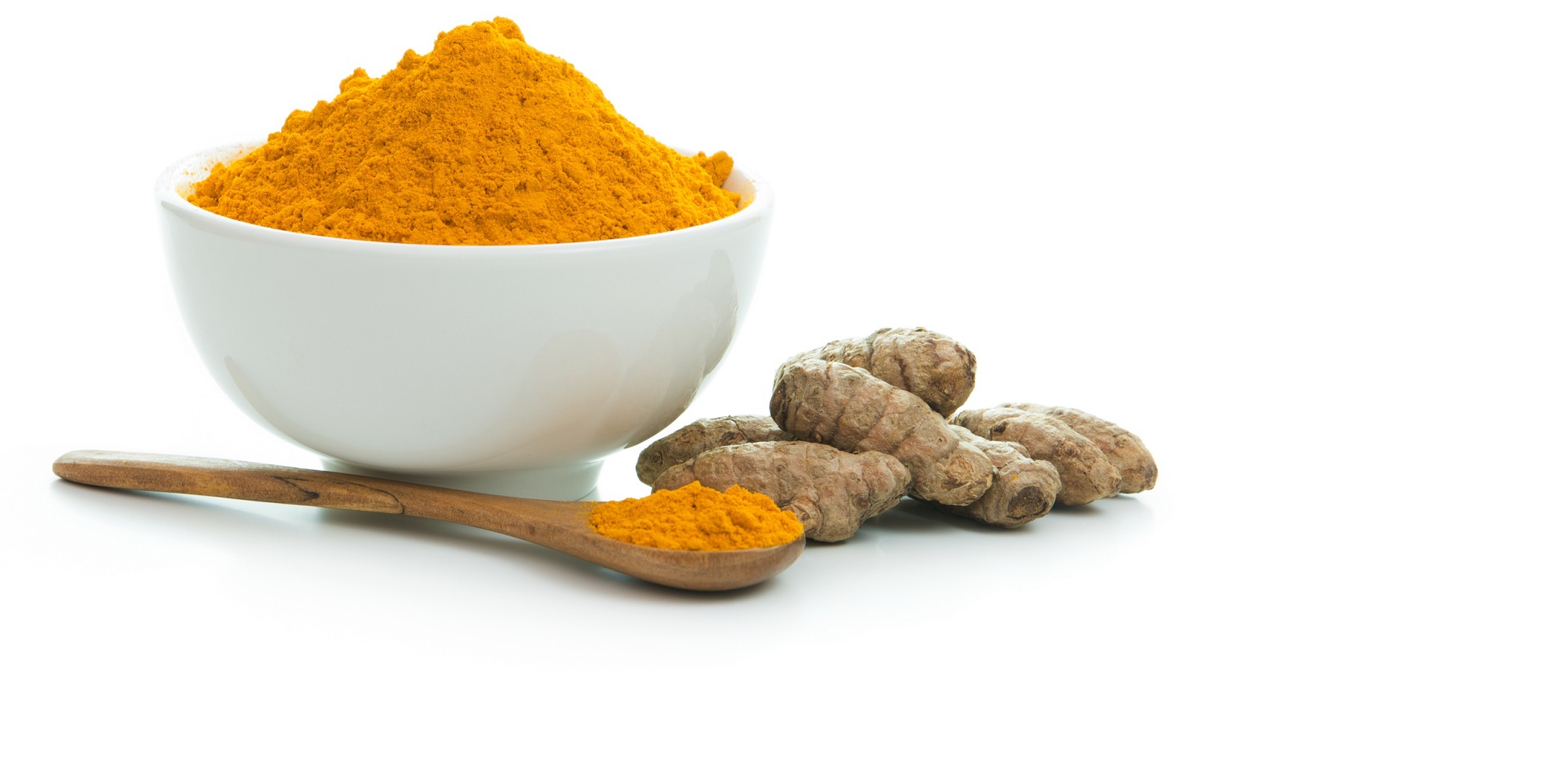 Curcumin and cancer:
Curcumin and cancer:
Research done by the Life Extension Foundation found that curcuminoids target ten factors involved in cancer development. This includes chronic inflammation, DNA damage and disruption of cell signaling pathways. Curcumin supplementation was shown to destroy cancer cell mitochondria, disrupt the cancer cell cycle and arrest stem cell development that facilitates further cancer cell formation.
There are hundreds of other studies that have shown that curcumin turns on natural apoptotic (cell suicide) switches in cancer cells. They also reduce inflammatory prostaglandins that promote cancer cell growth. A study out of China showed that Curcumin was able to induce apoptosis within triple negative breast cancer (TNBC) cells. TNBC is a type of cancer that defies conventional chemotherapy and radiation.
Curcumin and Candida Albicans
Curcumin has antimicrobial properties that can prevent growth of infections due to fungi, bacteria, protozoa or viruses. Anti-fungals are required to treat infections like candidiasis, athlete’s foot, thrush or ringworm. Hence, turmeric could benefit the treatment of yeast infections that are caused by a fungus. Turmeric can be an effective treatment of Candida albicans that causes yeast infections, due to the benefits offered by curcumin, like its ability to strengthen the immune system by increasing CD4 and CD8 counts. These two are glycoproteins that areturmeric for candida yeast infection needed to help the body deal with infections.
Excellent weight management tool
Curcumin supplement has been proven effective to help burn fat, and regulate your metabolism to reduce fat storage and give you more energy to live an active lifestyle.
Chinese Therapeutic Actions:
Activates blood circulation, eliminates blood stasis
Opens channels and collaterals to relieve pain
Reduces swelling
Allergies Tradicional Chinese Medicine
Seasonal allergies and Tradicional Chinese Medicine
 If you suffer from seasonal allergies, that familiar tickle in your nose and throat that signals the arrival of spring pollen very soon; sneezing, mildly congested or a runny nose, or perhaps some mild burning of your eyes or itchiness of your skin. All these symptoms, from a Chinese Medical point of view, point to the climactic influence of the spring season - Wind.
If you suffer from seasonal allergies, that familiar tickle in your nose and throat that signals the arrival of spring pollen very soon; sneezing, mildly congested or a runny nose, or perhaps some mild burning of your eyes or itchiness of your skin. All these symptoms, from a Chinese Medical point of view, point to the climactic influence of the spring season - Wind.
Chinese medicine views seasonal allergic rhinitis symptoms as being primarily caused by the pathogenic influence of wind. Wind is qualified by symptoms that occur quickly, are rapidly changeable, affect mostly the upper part of the body, and occur at a very surface level - for example, mucous membranes and skin.
From the perspective of Chinese medicine, those of us with underlying deficiencies, often of the spleen, kidney, or lung, are especially susceptible to invasion by wind, and, therefore, conditions like seasonal allergies.
Luckily, there are many natural options to help relieve allergy symptoms.
Chinese herbal medicine is A very effective choice, and can be combined with acupuncture for faster results.
One of the most effective TCM formulas is AllerEase; Formula explanation:
In Chinese medicine, people who contract airborne allergies, ipso facto, suffer from a defensive qi vacuity. Since the defensive qi issues from the middle burner, this defensive qi vacuity is mostly due to a chronically vacuous and weak spleen failing to engender the lungs and defensive qi. Because of the close recipirocal relationship between the spleen and kidneys, there may also be a kidney qi vacuity. In either case, external wind evils may take advantage of this vacuity to enter the body where they obstruct the lungs’ diffusion and downbearing. Because the patient’s spleen is habitually vacuous, there is a tendency to phlegm dampness. This phlegm may be hidden or deep-lying, meaning that, during ordinary times, it is not apparent. However, whenever the lungs’ diffusion and downbearing of fluids is inhibited, this phlegm backs up and spills over, thus becoming apparent as mucus.
Therefore, this formula is based on the saying, “The spleen is the root of phlegm engenderment; the lungs are the place where phlegm is stored.” Within it, Codonopsis, Astragalus, Coix, and Disocorea supplement the lungs, spleen, and kidneys, the three viscera which govern water metabolism in the body. Terminalia and Schisandra secure the lungs and specifically stop runny nose. Ledebouriella and Schizonepeta relatively gently dispel wind evils from the exterior while not damaging the defensive qi. Flos Magnoliae and Mentha open the orifices and free the flow of the nose, thus relieving nasal congestion. Periostracum Cicadae dispels wind and stops itching. Platycodon guides the other medicinals to the lungs and also transforms phlegm. Dry Ginger warms the lungs and transforms phlegm. The combination of Coix and Alisma seeps dampness via urination and, therefore, helps Atractylodes eliminate dampness. Licorice harmonizes all the other medicinals in the formula at the same time as helping fortify the spleen and supplement the qi.
Research outcomes:
Thirty-three patients with wind cold allergic rhinitis and an underlying lung-spleen vacuity were given a single course of treatment with this formula and then followed for six months. In six cases, their symptoms disappeared and did not recur for the full six months of the study. In 23 cases, their symptoms recurred after more than three months but less than six months. However, repeat treatment was able to eliminate their symptoms. Only four cases got no effect. Thus the total effectiveness of this formula was 87.8%.
One of the most ancient TCM formulas used for allergies is Yu Ping Feng San:
CLINICAL STUDIES AND RESEARCH
1. Prevention of respiratory tract infection: According to one study, Yu Ping Feng San was evaluated for its effect in preventing recurrent respiratory tract infection in 32
children who have had a history of frequent infections. The treatment protocol was to administer Yu Ping Feng Pian for 14 weeks prior to winter. The study reported an
overall effectiveness of 96.9%. Furthermore, the study noted that there was an increase in IgA, but no significant changes to IgG or IgM.8
2. Allergic rhinitis: According to one study, the use of Yu Ping Feng San was associated with good results to treat 495 patients with allergic rhinitis characterized
by deficiency of the exterior. Of 495 patients, the study reported significant improvement in 293 cases, improvement in 120 cases, and no effect in 79 cases. The
rate of effectiveness was 84. Information was unavailable on 3 individuals who did not complete the study.
3. Immunostimulant: Administration of Yu Ping Feng San has been associated with increased immunity. According to one study, the use of this formula increased IgG and IgA in mice. Another study reported that the use of this formula for 2 to 3 months increased NK cell count and activities.
4. Antiviral: According to one in vitro study, Yu Ping Feng San has demonstrated inhibition on the replication of influenza A viruses.
Another of the most basic formulas used during allergy season is Jade Screen ( based on Yu Ping Feng San). This formula is incredibly simple and elegant: expels wind (Ledeboureilla root), supports the lung system (Astragalus root), and supports the spleen system (Atractylodes). The simplicity of this formula also makes it highly adaptable for each individual patient's presentation.
Explanation
Jade Screen™ is a formula specifically designed to treat the manifestations of allergic rhinitis. The problem is becoming more and more common, partly because of an increasing genetic predisposition to allergy and partly through heavy atmospheric pollution in cities. Although this formula contains the classical prescription “Jade Wind-Screen Decoction” (Yu Ping Feng San), its main emphasis is not on tonification but on expelling Wind and restoring the diffusion of Lung-Qi to stop sneezing and nasal discharge. In addition to herbs which expel Wind and target the nose, there are three herbs which are included for their anti-allergy effect: Dan Shen, Wu Wei Zi and Wu Mei.
A deficiency of the Kidneys is often at the root of atopy (the tendency to allergic diseases such as atopic eczema, allergic asthma and allergic rhinitis). The formula is aimed primarily at treating the Manifestation (i.e. Wind in the nose) rather than the Root. To treat the Manifestation and the Root simultaneously, the formula could be combined with the Herbal Sentinel (Yang or Yin).
Advised Formulas: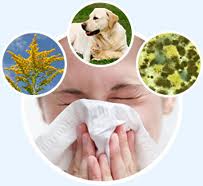
- AllerEase - Blue Poppy
- Yu Ping Feng San - Blue Poppy
- Jade Screen - Giovanni Maciocia
- Sneeze - Jade Herbal
- Bi Yan Pian
- Cang Er San
Nasal irrigation with saline can be extremely effective at washing allergens out of the nasal passageways and preventing an immune response. Additionally, the saline helps to moisturize the nasal membranes and control swelling. Goldenseal and/or grapefruit seed extract are great additions to the traditional saline wash.
One of the best choices for effective and side effect free treatment is acupuncture. Acupuncture works incredibly well because it not only relieves current symptoms, but also balances the immune system and corrects underlying deficiencies to help prevent symptoms from recurring. Regular treatments are most effective during allergy season, ideally starting acupuncture therapy a few weeks before symptoms hit their peak.
Supplements can also be of great support to your system this time of year. Quercitin can help to normalize the histamine reaction, Bromelain thins mucous and reduces nasal passage swelling and inflammation, and good quality probiotics help to normalize large intestine and gut function and, therefore, support the immune system as a whole.
Remember, there's no reason to suffer this season. Try some of the many natural options available to you to find relief from allergy symptoms!
Food Combining and Chinese Medicine
CHINESE DIETARY PRINCIPLES: 
According to Traditional Chinese Medicine it is Qi, or energy, which is responsible for moving and transforming the food we eat. The Stomach rots and ripens the food and the Spleen transforms and transports the refined Food Essence up towards the Lungs while the Stomach sends the rest of the food down to the Small Intestines. In Chinese Medicine the Spleen extracts Food Qi from food and this forms Blood in the Heart with the assistance of the Original Qi from the Kidneys. The Spleen is therefore the central essential organ for the production of both Qi and Blood.
When we overeat, eat too many hard to digest foods or eat improperly combined foods that food may become stagnant and accumulates instead of being dispersed and transformed. Undigested food can obstruct the Stomach and prevent the Stomach Qi from descending. Such accumulated stagnant food causes stagnant Qi, rebellious Stomach Qi, Stomach Heat and/or Dampness. This results in belching, sour regurgitation, nausea, etc. It may also give rise to or aggravate other conditions such as Blood stagnation and accumulation of Phlegm.
Chinese dietary principles are very old and do not take into account the great changes that have occurred in the growing and production of food in the past few decades. Modern food is subject to considerable chemical manipulation and a great many of the food additives can obviously be a cause of stomach problems and other disorders.Chinese Medicine says that the Qi comes from the purest part of the foods — the flavor or aroma. Its ability to supplement Qi is directly proportional to this aroma. Chinese dietary theory also maintains that food should be freshly made and eaten within 24 hours.
THE NATURE OF FOOD ACCORDING TO CHINESE MEDICINE:
Cold Foods:
• These include raw vegetables, salads, fruit, cold drinks and ice-cream. An excessive consumption of these foods will tend to create Cold in the Spleen and Stomach and ensuing epigastric pain.
• If food or drink has been stored in the refrigerator it should be allowed to heat up to room temperature before being consumed. This is especially true for persons who tend to be Spleen Qi deficient. Such persons should eat fruit and salads which have been warmed up to room temperature.
Hot-Spicy Foods:
• These include curries, spices, lamb, beef and alcohol. An excessive consumption of these foods produces Stomach Heat which may manifest as burning epigastric pain.
Sugar and Sweets:
• An excessive consumption of these may tend to produce both Dampness and Heat in the Stomach and Spleen Qi deficiency. When eaten with hydrogenated oils and sugars which are extremely dampening chocolate tends to foster Damp Heat.
Greasy Foods, Fried Foods and Dairy Foods:
• An excessive consumption of these foods leads to the formation of Phlegm or Dampness in the Stomach.
Citrus Fruits:
• Citrus fruits are sweet and sour and these two flavors in combination tend to be very dampening according to Chinese Five Element theory. Persons with a tendency to Dampness should be careful not to combine citrus fruits with other foods and not to overeat them.
Coffee:
• Drinking coffee exhausts the Kidney Yin and Yang and causes Spleen Qi to be lost.
THE PRINCIPLES OF FOOD COMBINING:
Proper food combining is based on the following principles:
1) That the stomach cannot be both acid and alkaline at the same time because acid and alkaline digestive juices will neutralize each other.
2) Fruits require an alkaline digestive environment.
3) Proteins require an acid digestive environment.
4) Starches require an alkaline digestive environment.
What happens if we violate these principles?
The best way to describe what happens if we violate these principles is by way of an example. Suppose we eat a protein such as meat with a starch such as potato. The body must provide aciddigestive juices to digest the meat and alkaline digestive juices to digest the potato thereby neutralizing each other’s digestive juices. This results in neither food getting properly digested. On the contrary most of the protein, being in the stomach for so long putrefies and most of the carbohydrate ferments. Foods that have been putrefied or fermented generate toxic acids in the body. The putrefaction and fermentation is experienced as gas, flatulence, heartburn and acid indigestion.
What happens if we follow good food combining practices?
Improper food combinations, food additives, polluted water, air and stress cause the body to become toxic and acidic. Fruit as well as vegetables have the unique ability to neutralize the acids that build up in our systems. By eating high-water content foods, properly combined foods and eating fruit correctly puts us on the road to better health by promoting better digestion, assimilation and elimination. Fruit:
Fruit:
• Fruit should not be eaten with protein because fruit acids inhibit the secretion of hydrochloric acid and thus interfere with protein digestion.
• It is best not to combine fruits with vegetables (especially cooked vegetables), proteins or starches because if such a combination of foods is eaten the digestion of the fruit will be delayed and subject to fermentation. All fruits go well with sprouts and we may also combine fruit with lettuce and celery.
• We can eat acid fruits with nuts or cheese.
Acid fruits are: blackberries, grapefruit, lemons, limes, oranges, pineapples, plums, pomegranates, raspberries and strawberries
• Melons are best eaten alone.
• Wait 20-30 minutes after eating fruit before eating other foods.
Dried Fruits:
• Dried sweet fruits should be used sparingly. Use but one kind at a meal – in small amounts. They should be combined only with sweet fruit and/or lettuce and/or celery.
Citrus Fruits:
• Citrus fruits are best eaten at monomeals or at bimeals of oranges with grapefruits, pineapple, strawberries, etc.
• It is better not to combine them with starches such as breads, pastas, grains, potatoes, carrots, beets, squash, peanuts etc.
• It is better not to combine them with proteins except with nuts or seeds
.Non Starchy Vegetables (High Water Content Foods):
• Non starchy vegetables do not need their own specific digestive juices. They will break down in either acid or alkaline digestive mediums.
• It is OK to eat protein (but only one type at a time) with non starchy vegetables.
• Examples of non starchy vegetables are: asparagus, broccoli, Brussels sprouts, cabbage, celery, chard, collards, corn, cucumber, eggplant, endive, escarole, green beans, kale, kohlrabi, lettuce, okra, parsley, spinach, sprouts, summer squashes, sweet pepper, tomatoes, watercress and zucchini.
Nuts and Seeds:
• Concentrated foods such as nuts and seeds should be eaten with or as part of a vegetable salad. The water content of the salad vegetables offsets the lack of water in nuts and seeds.
• Nuts and seeds are protein-fat foods. Fats are slow to digest and their presence with protein makes nuts particularly slow-digesting. Delayed digestion encourages fermentation and putrefaction.
• After eating nuts three hours should elapse before eating fruit.Avocado:
• Avocado combines well with starches, such as whole grain bread, with all cooked or raw vegetables, and with fruit such as papaya, mango, banana, and orange. Do not combine avocado with protein.
Lettuce and Celery
• Lettuce or celery may be combined with fruits (except melons).
• Lettuce is an excellent combination with more concentrated foods of lower water content such as pecans, sunflower seeds, walnuts, sesame seeds, filberts and pine nuts.
Vegetables:
• All vegetables should be soaked at least three hours or overnight to activate the enzymes in them–otherwise they are indigestible.
Calcium: 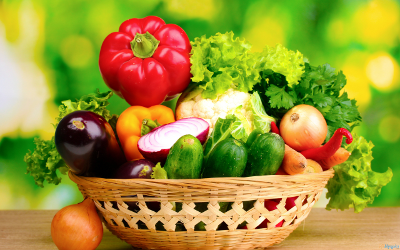
• The best sources of calcium are: raw sesame seeds, all raw nuts, kelp, dulse, all leafy greens, and concentrated fruits such as figs, dates and prunes. Most fruit contains ample calcium.
Sandwiches:
• The very nature of a typical sandwich is that it combines a protein with a carbohydrate and therefore it wastes a great deal of digestive energy. Properly combined sandwiches on whole-grain bread, using tomato, avocado, and cucumber, with lettuce or sprouts as fillings are energizing. Always toast the bread lightly to break down the glutens and make it more digestible.
Amino Acids:
• The following fruits and vegetables contain all the amino acids not produced by the body: carrots, bananas, Brussels sprouts, cabbage, cauliflower, corn, cucumbers, eggplant, kale, okra, peas, potatoes, summer squash, sweet potatoes and tomatoes.
by John G. Connor, M.Ac., L.Ac., edited by Barbara Connor, M.Ac., L.Ac.
REFERENCES
Avery, Phyllis, Stop Your Indigestion, Vista, CA: Hygeia Publishing Co. 1993
Diamond, Harvey and Marilyn, Fit for Life, New York: Warner Books 1985
Dries, Jan & Inge Dries, The Food Combining Bible, London: Element (Harper Collins) 2002
Flaws, Bob, Arisal of the Clear, Boulder, CO: Blue Poppy Press 1991
Maciocia, Giovanni, The Foundations of Chinese Medicine, Edinburgh: Churchill Livingstone 1989
Phytoestrogens
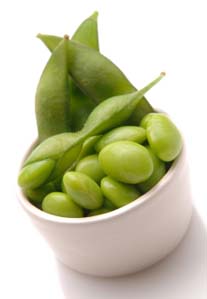 Phytoestrogens are paradoxical. Because of their structural similarity to the physiological oestrogens, they have been assumed to increase the risk of breast cancer. However, nations where the largest amounts of phytoestrogens are consumed in the diet have the lowest incidence of and rate of death from breast cancer. Although these epidemiological observations do not prove that phytoestrogens have anti-cancer properties, many preclinical experiments support this concept. Some indicate that early life exposure to phytoestrogens may be critical for breast cancer prevention.
Phytoestrogens are paradoxical. Because of their structural similarity to the physiological oestrogens, they have been assumed to increase the risk of breast cancer. However, nations where the largest amounts of phytoestrogens are consumed in the diet have the lowest incidence of and rate of death from breast cancer. Although these epidemiological observations do not prove that phytoestrogens have anti-cancer properties, many preclinical experiments support this concept. Some indicate that early life exposure to phytoestrogens may be critical for breast cancer prevention.
The issues surrounding phytoestrogens are relevant to us as practitioners of Chinese medicine because some Chinese herbs contain phytoestrogens. This newsletter will attempt to explain what phytoestrogens are, the role they may play in relation to breast cancer and to summarize the clinical studies that have been done so far.
What are phytoestrogens?
The name "phytoestrogens" is rather misleading as it implies a plant source of oestrogens. Phytoestrogens are not oestrogens: they have a chemical structure which is similar to but not the same as that of oestrogens and their effect on the body is not the same as that of oestrogens. The term phytoestrogen actually describes a property that has been identified in some foods, plants and herbs. There is not, as yet, a definitive list of substances that contain phytoestrogens. However, they have been found in the following classes of substances:
• lignans
• isoflavones
• coumestans
GLOSSARY
Phytoestrogen compounds found in plants and herbs
Oestrogen a generic term for estrus-producing compounds; the female sex hormones
Oestradiol a type of oestrogen
Progesterone a steroid hormone
Oestrogen-antagonistic works against oestrogen
Oestrogen-agonistic works with oestrogen
Tamoxifen a drug used in the treatment of breast cancer which has weak oestrogenic effects
Goserelin an oestrogen-inhibiting drug used in the treatment of breast cancer
Lignans, isoflavones, coumestans classes of plant substances in which phytoestrogens are found
Hormone receptor a part of a cell into which a hormone locks in order to exert its effect on the body
Isoflavones is the group in which there is most interest and which is present in soya products. Lignans and coumestans are currently rather understudied. Structural similarity of oestrogens and phytoestrogens
What is hormone-sensitive breast cancer?
The growth of many normal tissues, including breast tissue, is under hormonal regulation and the cancers which arise in them often retain sensitivity to changes in the hormone environment. Therefore, hormone therapy is an essential part of management of any hormone-sensitive cancer.
To determine whether or not a cancer is hormone-dependant, a woman with breast cancer will always be given what is known as a hormone receptor assay, i.e. a test that measures the presence of oestrogen and progesterone receptors in the tumour cells. If these receptors are present, the tumour is said to be oestrogen-receptor positive or progesterone-receptor positive and is thus hormonal. The role of oestrogen and phytoestrogens is not relevant to non-hormonal cancers.
Every cell contains "hormone-receptors". It is when hormones, such as oestrogen, lock on to these receptors that they exert their effects: if they cannot lock on, then they have no effect. So, therefore, it is only when oestrogen locks on to a hormone receptor that, in terms of breast cancer, it becomes "dangerous", as oestrogen has a proliferative effect on breast cancer cells. Phytoestrogens are also able to lock onto hormone receptors and they therefore block the oestrogen from being able to do the same. It is in this way that it is thought that phytoestrogens help protect against breast cancer.
Although phytoestrogens are often compared to oestrogens, the effect that they have on oestrogen levels in the body is not clearly defined. However, the vast majority of the clinical studies done so far point towards the fact that phytoestrogens do not have the same effect as oestrogens and that, to the contrary, they help to prevent the proliferation of cancerous cells in the breast.
Oestrogen in the "right" quantity has a purely beneficial effect on women's health. It is an excess of oestrogen that has been linked with the rise in breast cancer. In fact, it is has been proved that women on HRT have an increased risk of breast cancer. A Swedish study of 23, 000 hormone users reported that the incidence of breast cancer compared with that in non-users was increased after six years' use. One of the most recent British studies of 5000 women taking HRT showed that breast cancer mortality in these women compared with the general population rose from 0.55 per 1000 in the earlier period of follow-up to 1984, to 1 per 1000 between 1984 and 1988. Whenever a woman menstruates, oestrogen is produced by the ovaries; it therefore follows that, over a lifetime, the more periods a woman has the more oestrogenic-stimulation occurs. It has been proven that there is a direct, inverse correlation between the age of menarche in women and the number of children they have with the incidence of breast cancer, i.e. the earlier menarche is and the fewer children they have, the higher the chances of developing breast cancer.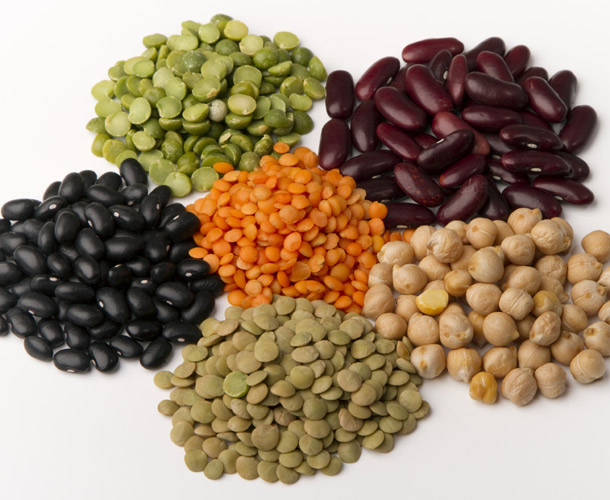 Food sources of phytoestrogens:
Food sources of phytoestrogens:
• Oilseeds, especially flaxseed
• Cereals (e.g. rye, wheat, oats)
• Vegetables (e.g. garlic, squash, asparagus, cabbage, spinach)
• Legumes (e.g chickpeas, kidney beans, lentils)
• Fruits (e.g. pears, plums)
• Soy protein
• Seaweed
• Beansprouts
• Hops
Soya beans contain the most concentrated source of isoflavones and other soya products such as tofu, tempeh and soya milk also contain appreciable quantities of these materials. Lignans, however, another subgroup in which phytoestrogens are found, are associated more with diets high in plant fibre.
There are currently three main views as to the role phytoestrogens may play in preventing and treating breast cancer.
1. ANTIESTROGENIC EFFECT
The most widely held view is that phytoestrogens help to prevent the spread of cancerous cells in the breast, i.e. that they are oestrogen antagonistic. Their effect could be compared to that of the commonly-prescribed drug tamoxifen. Both appear to exert most of their effect by binding to the oestrogen receptor, thereby preventing the activity of circulating estradiol (a type of oestrogen). Obviously, the great advantage of phytoestrogens compared to tamoxifen is that they do not have any side effects and they continue working indefinitely, whereas, according to some, tamoxifen usually stops working after approximately a year.
It has long been known that breast cancer, as well as other cancers such as colon, prostatic, endometrial and ovarian, all have lower incidences in Asia and eastern Europe than in western countries. Japan has consistently been reported to have the lowest risk of hormone-dependent cancers. Moreover, migrants to western countries from Asia who maintain their traditional diet do not increase their risk of these diseases, whereas an increased risk for these diseases accompanies a change toward a westernized diet. Women who do suffer from breast cancer in Japan have a better prognosis that those with breast cancer in the US or Britain. These differences apply to postmenopausal women and are apparently independent of stage of disease at diagnosis. A review of breast cancers in Japanese and white women in Hawaii showed that Japanese women had a higher number of in situ tumours, fever lymph node metastases, and those with metastases were less likely to have three or more nodes involved. Stage for stage, women of Japanese origin in Hawaii have longer survival times after breast cancer resection than white women. These facts point towards the fact that women who have a diet high in phytoestrogens, e.g, a diet containing a lot of soya products, have a lower risk of contracting breast cancer.
2. OESTROGEN-AGONISTIC EFFECT
The opposing view, which is much less commonly held, is that phytoestrogens (specifically genistein, daidzein and equol) actually exhibit agonistic actions on oestrogen-dependent gene expression in breast cancer cells. Proponents of this view agree that, although the significance of phytoestrogens as estrogenic effectors in humans have been suggested to be insignificant, the potential combinatorial actions of these compounds would suggest that the collective effects of multiple phytoestrogens may result in an overall increase in estrogenic potency and possibly clinical significance.
3. BALANCING EFFECT
Another view, which is as yet not supported by any clinical studies, is that phytoestrogens have a balancing or levelling effect on oestrogen levels. Therefore, when production of oestrogen is low, the phytoestrogens can boost oestrogen activity and when production of oestrogen is excessive, phytoestrogens appear to antagonise oestrogen's activity by locking onto the hormone receptors.
CONCLUSION
The overwhelming evidence is that phytoestrogens do not stimulate the growth of cancerous cells in the breast. The most likely way that they achieve their oestrogen-antagonistic effect is through a competitive mechanism whereby the phytoestrogens occupy the receptor sites of tumour cells without enhancing their growth but keeping the body's oestrogens from contacting the receptor and simulating cell proliferation.
Assuming that this is the case, let us look at six possible scenarios of women who are all taking Chinese herbs which contain phytoestrogens in order to illustrate their safety:
a) a healthy woman without breast cancer:
phytoestrogens prevent the proliferation of hormone-sensitive breast cancer cells and improve health in many other ways (see below).
b) a woman with asymptomatic hormone-sensitive breast cancer:
phytoestrogens compete with oestrogens over the oestrogen receptors on the surface of the cancer cells and therefore they would be beneficial.
c) a woman with non-hormonal breast cancer:
the cancerous cells would not be affected one way or the other by phytoestrogens.
d) a woman with hormone sensitive cancer taking tamoxifen:
phytoestrogens would not be harmful because tamoxifen firmly blocks off the estrogen receptors of the cancerous cells.
e) a woman with hormone-sensitive breast cancer taking goserelin (Zoladex):
goserelin does not block receptors but it does reduce the level of estrogen in the body. As in scenario one, the phytoestrogens would lock onto the cell receptors and help prevent the proliferation of cancer cells.
f) a woman with hormone-sensitive breast cancer who is not taking either tamoxifen or goserelin:
this is a very unlikely case but, as in scenario e), the phytoestrogens would block the hormone cell receptors.
Therefore, we can see that, going on the current evidence about the effect of phytoestrogens, it is not only safe, but also beneficial for women with hormone-sensitive or non-hormonal breast cancer to take herbs which contain phytoestrogens. We should also remember that it is impossible to avoid phytoestrogens altogether anyway, as they naturally occur in many everyday foods.
OTHER BENEFICIAL EFFECTS OF PHYTOESTROGENS 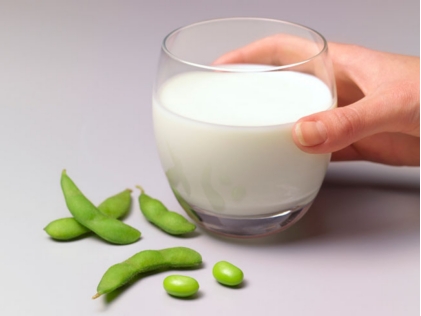
The following benefits of phytoestrogens on our health have all been proved:
• they have a positive effect on the lipoprotein profile
• they improve many of the symptoms associated with menopause
• they reduce the risk of cardiovascular disease
• they reduce cholesterol levels
• they have a beneficial effect on osteoporosis by increasing bone density
• they have an anti-viral effect
• they are bacteriocidal
• they have anti-fungal properties
• they have anti-oxidant properties
• they are anti-mutagenic
• they are anti-hypertensive
• they are anti-inflammatory
• they have anti-proliferative properties
CLINICAL STUDIES
1. A Review of the clinical effects of phytoestrogens
In vitro studies using human breast cancer cell lines have confirmed the antiproliferative effects of phytoestrogens. Enterolactone, enterodiol, and synthetic mammalian lignan derivatives were shown to inhibit growth by 18-20% in vitro. The effects of synthetic and naturally occurring flavonoids were tested on the same breast cancer cell line. In all cases, antiproliferative effects were noted. These effects were not purely cytostatic, as cell death was found to increase dosedependently.
2. Regulation of Inducible nitric oxide synthase by dietary phytoestrogen in MCF-7 human mammary cancer cells.
The effects of the phytoestrogen biochanin A on the growth of MCF-7 human breast cancer cell line was examined. The results showed that biochanin A treatment induced dose- and time-dependent inhibition on MCF-7 cell growth at concentrations above 20 microg x ML (-1). An examination of treated MCF-7 cell morphology revealed condensation of the chromosome and dehydration of the cytoplasm, suggesting apoptosis as an important factor in biochanin A-related cell growth inhibition. The results also showed that at a concentration of 40 microg x mL (-1), biochanin A decreased the levels of inducible nitric oxide synthase, thus inhibiting the production of nitric oxide, a known second messenger and inducer of apoptosis, and affecting the overall cell protein pattern. No significant difference in superoxide dismutase protein levels were, however, detected at concentrations of 40 or 100 microg x mL (-1) of biochanin A. The data suggest that the inhibitory effects of biochanin A on human breast cancer cell growth are linked to inducible nitric oxide synthase and the associated production of nitric oxide.
3. Potential tissue selectivity of dietary phytoestrogens and oestrogens
The recent discovery of a second oestrogen receptor subtype, oestrogen receptor-b, may significantly advance our understanding of tissue specific effects of oestrogenic compounds, both natural and synthetic. Although specific effects mediated by oestrogen receptor-b in vivo remain to be elucidate, hypothetically the existence of two oestrogen receptor subtypes (differing in both tissue distribution and biological activity) may help to explain the curious pharmacological behaviour of many oestrogenic compounds, including the naturally occurring dietary phytoestrogens.
4. Effects of phytoestrogens on aromatise, 3beta and 17beta-hydroxy steroid dehydrogenate activities and human breast cancer cells.
This study explored the mechanisms by which phytoestrogens may exert cancer-preventive effects. Phytoestrogens were tested for estimating anti-aromatise, anti-3beta-hydroxy steroid dehydrogenate delta5/delta4 isomerase (3beta-HSD and anti-17beta-hydroxy steroid dehydrogenate (17beta HSD) activities in human placental microsomes. It was found that isoflavonoids and compounds which presented the phenolic B ring in the 3 position on the pyran ring preferentially inhibited 3beta-HSD and/or 17beta-HSD activities than aromatise activity. The interactions with the oestrogen receptor using a stably transfected human breast cancer cell line (MVLN) were also evaluated. Also, phytoestrogens were evaluated for their effects on the proliferation in oestrogen-dependent (MCF-7) and independent (MDA-MB231) human breast cancer cells. A structure-activity relationship was established and determined regions or/and substituents essential for these different activities. However, at high concentrations, it seems that some phytoestrogens exert their protection against breast cancer through other oestrogen-independent mechanisms.
5. Phytoestrogens have agonistic and combinatorial effects on oestrogen-responsive gene expression in MCF-7 human breast cancer cells
This study sought to investigate whether oestrogen-dependent gene expression may be further influenced by the collective treatment of breast cancer cells with multiple phytoestrogens. Accordingly, MCF-7 breast cancer cells were transfected with oestrogen-responsive reporters followed by treatment with one of four phytoestrogens (genistein, daidzein, formononetin, and equol) or a combination of these in the absence of estradiol. The results demonstrated clear-cut agonistic effects of phytoestrogens on oestrogen-dependent gene expression. Moreover, combinatorial treatment consistently stimulated reporter activity above that observed for individual phytoestrogens. In as much as the phytoestrogens tested are frequently found together in food sources, these combinatorial responses may more accurately reflect the consequences of in vivo exposure.
6. Case-control study of phytoestrogens and breast cancer
Researchers in Perth, Australia, obtained 72-hour urine samples from 144 women with newly diagnosed breast cancer and followed an equal number of age-matched, non-sufferers. The urine sample were monitored for several compounds found naturally in soya-rich foods and vegetable fibre-analogues (isoflavones and lignans), since excretion of these compounds mirrors both dietary intake and bioavailability. After adjustment, high excretion rates of both groups of compounds were associated with a statistically significant reduction in breast cancer risk. Additionally, the larger the urinary output of these molecules the greater the protection.
7. Interaction of Oestrogenic Chemicals and Phytoestrogens with Oestrogen Receptor ß
This study found that, while the estrogenic potency of industrial-derived estrogenic chemicals is very limited, the oestrogenic potency of phytoestrogens is significant, especially for Erß, and they may trigger many of the biological responses that are evoked by the physiological oestrogens.
By Giovanni Macicocia
Ginseng Benefits
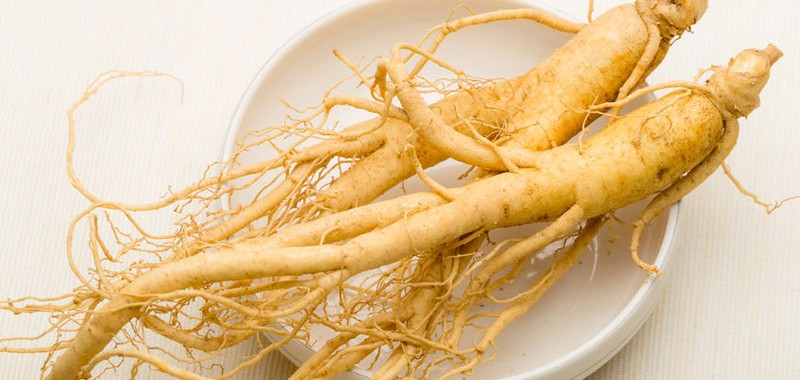 Asian Ginseng is one of the most highly regarded of herbal medicines in the Orient, where it has gained an almost magical reputation for being able to promote health, general body vigour, to prolong life and treat many ailments including depression, diabetes, fatigue, ageing, inflammations, internal degeneration, nausea, tumours, pulmonary problems, dyspepsia, vomiting, nervousness, stress, and ulcers.
Asian Ginseng is one of the most highly regarded of herbal medicines in the Orient, where it has gained an almost magical reputation for being able to promote health, general body vigour, to prolong life and treat many ailments including depression, diabetes, fatigue, ageing, inflammations, internal degeneration, nausea, tumours, pulmonary problems, dyspepsia, vomiting, nervousness, stress, and ulcers.
Asian Ginseng has a history of herbal use going back over 5,000 years. It is one of the most highly regarded of herbal medicines in the Orient, where it has gained an almost magical reputation for being able to promote health, general body vigour and also to prolong life. The genus name Panax is derived from the Greek word meaning "panacea" or "all-healing"; the species ginseng is said to mean "wonder of the world". Both terms refer to the medicinal virtues of the plant. In the last decade it has gained popularity in the West and there is extensive literature on the beneficial effects of ginseng and its constituents.
Panax Ginseng is thought to be even more beneficial when taken with Ginkgo Biloba.
Ginseng has been listed by some as useful in the treatment of anemia, cancer, depression, diabetes, fatigue, hypertension, insomnia, shock, effects of radiation, effects of morphine and cocaine use, environmental, physical and mental stress, and chronic illness. It has been said to act as a stimulant, promote endurance, increase life expectancy, relax the nervous system, improve mental awareness, encourage proper hormonal functions, improve lipid levels, lower cholesterol, improve nerve growth, and increase resistance to disease. It has been used to increase the appetite and bodily energy, regulate menses, ease childbirth, increase fertility of women, and treat periodontal disease
Research has shown that ginseng may have the ability to act as an "adaptogen", prolonging life by combating viral infections and Pseudomonas aeruginosa. Research continues to support ginseng's protective role against anti-cancer treatments and drugs, perhaps even countering the side effects of chemotherapy.
There is some thought that ginseng may be useful for the prevention of abuse and dependence of opioids and psychostimulants.
Ginseng has been used to both stimulate and relax the nervous system. It increases capillary circulation in the brain and decreases the effects of stress. Though there are many kinds of ginsengs in the world but they cannot rival Asian Ginseng in ingredients and medicinal effects. It contains as many as 29 different ginsenosides while the others contains 8-9.
Asian Ginseng contains anti-ageing substances such as anti-oxidants and insulin-like substances which are not found in any other type of ginseng.
Ginsenosides are a diverse group of steroidal saponins, which demonstrate the ability to target a myriad of tissues, producing an array of pharmacological responses. However, many mechanisms of ginsenoside activity still remain unknown. Since ginsenosides and other constituents of ginseng produce effects that are different from one another, and a single ginsenoside initiates multiple actions in the same tissue, the overall pharmacology of ginseng is remains remarkably complex and esoteric.
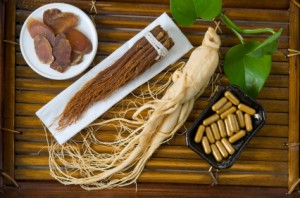 In western herbal medicine, Panax ginseng's regulating effects on the immune system have been studied for potential effectiveness in preventing colds, flu, and some forms of cancer. In clinical studies, Panax Ginseng has been shown to lower blood levels of both sugar and cholesterol, therefore it may help treat type 2 diabetes and high cholesterol. Its other potential uses are not as well defined, however. In separate studies of laboratory animals and humans, Panax ginseng had a relaxing effect on muscles in the lungs. The resulting airway expansion may help relieve asthma symptoms and other lung conditions that result from constricted airways.
In western herbal medicine, Panax ginseng's regulating effects on the immune system have been studied for potential effectiveness in preventing colds, flu, and some forms of cancer. In clinical studies, Panax Ginseng has been shown to lower blood levels of both sugar and cholesterol, therefore it may help treat type 2 diabetes and high cholesterol. Its other potential uses are not as well defined, however. In separate studies of laboratory animals and humans, Panax ginseng had a relaxing effect on muscles in the lungs. The resulting airway expansion may help relieve asthma symptoms and other lung conditions that result from constricted airways.
In other studies, a combination of Panax Ginseng and gingko biloba is believed to boost memory and thinking processes. Early results from laboratory study may show that chemicals in Panax ginseng promote the growth of blood vessels, which could be valuable in treating extensive injuries.
Recent reports on the pharmacology of ginseng indicate a wide range of effects, including influence on the central nervous system, endocrine and adrenocortical systems, internal, organs, metabolism, blood pressure and sugar, gonadotropic activity, cellular ageing, tumours, and stress. Ginseng appears to relieve stress, increase sexual activity, and facilitate mating in laboratory animals. The herb has been reported to be effective in prolonging survival time during cardiac arrest. It is reported to show hypoglycemic activity. Asian Ginseng has also been identified to protect the testis against 2,3,7,8-tetrachloro-di-benzo-di-p-DIOXIN inducing testicular damage. This particular dioxin is the most dangerous of perhaps the most toxic chemical group known to science. Dioxins are known to cause cancer in humans.
Other data shows it works not only in preventing adult diseases including cancer, diabetes, hypertension, and impotence but can also aid in treatment.
German Commission E monograph and WHO support the use of ginseng as a prophylactic and restorative agent for enhancement of mental and physical capacities, in cases of weakness, exhaustion, tiredness, and loss of concentration, and during convalescence (WHO, 1999). In general, ginseng is used as a tonic, stimulant, aphrodisiac, immune booster, blood pressure modulator (lowers and raises, depending on needs), and a modulator of blood sugar level (lowers or raise, depending on needs).
Ginseng Herb Notes
Latin Name
Panax Ginseng
Common Names
Asian Ginseng, Chinese Ginseng, Guigai, Jiln Ginseng, Korean Ginseng, Ninjin, Oriental Ginseng, Panax schinseng, Red Ginseng, Ren Shen, Seng, Shen Lu, Shen Ts'Ao, Tane-Ninzin
Properties
adaptogen, alterative, anti-complement, auto-immune stimulant, anti-oxidant, anti-tumour, anti-viral, aphrodisiac, carminative, demulcent, emetic, expectorant, nervine, phagocytic, psychotropic, somnogenic, stimulant, stomachic, tonic.
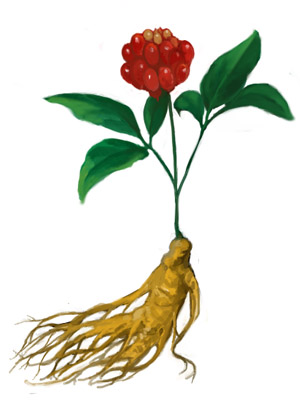 Indicated for
Indicated for
Atherosclerosis, adrenal insufficiency, ageing, anemia, cancer, chronic illness, depression, diabetes, dyspepsia, effects of radiation, effects of morphine and cocaine use, encouraging proper hormonal function, fatigue, heart problems, hypertension, impotence, increasing energy, infertility, inflammation, improving abstract thinking, reaction times and mental awareness, improving lipid levels, improving nerve growth, increasing life expectancy, increasing resistance to disease, insomnia, internal degeneration, lowering cholesterol, mental wellbeing, nausea, nervousness, periodontal disease, physical wellbeing, poor memory, poor circulation, pseudomonas aeruginosa, pulmonary problems, relaxing the nervous system, regulating menses, shock, stress (environmental, physical and mental), stimulating appetite, tiredness, tumours, ulcers, vaginal dryness, viral infections, vomiting, weakness.
Ginseng should not be taken, without prior consultation with a doctor, if you:
* Are pregnant or breast-feeding
* Have diabetes
* Have high blood pressure
or are taking:
* Anti-coagulants
* Diabetic medicine
* Diuretics
* Heart medicine
* Hormone replacement therapy
* Monoamine oxidase inhibitors
* Nervous system stimulants
* Pain killers
Consuming large amounts of caffeine or other stimulants while taking ginseng can result in nervousness, sleeplessness, elevated blood pressure, and other complications.
Avoid ginseng if you have an acute illness, uncontrolled high blood pressure, an irregular heart rhythm, or if you are pregnant.
Higher than commonly recommended doses may cause nervousness, insomnia, headache, skin eruptions, stomach upset, and increased menstrual bleeding and breast tenderness. If you experience any of these reactions, reduce your dose or stop taking the herb.
Panax ginseng is different from American ginseng and Siberian ginseng. They are not interchangeable.
Aumento de precios de la marca Blue Poppy
*NOTICE*
The Blue Poppy brand has substantially raised the prices of its products in all ranges (Original, Classic, Pediatric, External and Great Nature).
We are thus forced to reflect on the increase that we have already been enduring since the beginning of the year. We ask for your best understanding and we remain available for any questions.
02.06.2023
Infertility and Chinese Medicine
 There is a long recorded history of Chinese herbs being used in the treatment of infertility. In fact, records indicating herbal treatment of infertility and miscarriage date back to 200 A.D., including mention of formulas that are still used for those same purposes today. The first book devoted solely to gynecology and obstetrics, "The Complete Book of Effective Prescriptions for Diseases of Women," was published in 1237 A.D.
There is a long recorded history of Chinese herbs being used in the treatment of infertility. In fact, records indicating herbal treatment of infertility and miscarriage date back to 200 A.D., including mention of formulas that are still used for those same purposes today. The first book devoted solely to gynecology and obstetrics, "The Complete Book of Effective Prescriptions for Diseases of Women," was published in 1237 A.D.
Alternative TCM treatments have become increasingly popular in Western countries as more and more couples find out firsthand how effective and safe they are. It is with good reason that more than a quarter of the world's population regularly uses Chinese medicine as part of their health care regimen and that TCM is the only form of classical medicine that is regularly used outside of its country of origin.
According to Maciocia (1998, p. 691) infertility is defined as “…the inability to produce offspring in a woman who has been trying for two years, who has a normal sexual life and, of course, whose partner has normal reproductive function”. If a woman has never been pregnant and has been trying to fall pregnant for 2 or more years than this is considered primary infertility, if however a woman has previously been pregnant (even if she miscarried) and has been trying for 2 or more years than this is considered secondary infertility.
A woman’s optimal period of fertility is between 18 and 35 years of age, during this time there are between 1,000,000 (18 yr) and 100,000 (35 yr) follicles left in the woman’s ovaries (Annon., 2010). However, many factors can hinder or interfere with a woman’s ability to become pregnant, including endometriosis, pelvic inflammatory disease, absence of ovulation, etc.
Both Western medicine (WM) and traditional Chinese medicine (TCM) recognise infertility as a gynaecological disorder, however, the methods of diagnosis and treatment are considerably different. IVF and assisted reproduction therapy (ART) are preferred choices of treatment in WM while in TCM, Chinese herbal medicine and/or Acupuncture are the treatments of choice.
Traditional Chinese Medicine (TCM) and Biomedical Aetiology and Treatment of Infertility
Causes of Infertility include: constitutional weakness, overwork, excessive physical work, excessive sexual activity at an early age, invasion of cold, dietary inadequacies, any of which can result in either an empty or full condition. According to Maciocia (1998, pp. 695-696) infertility is either an empty or full condition, but can manifest in an individual as a combination of both full and empty patterns. For example, a woman may have an underlying Kidney deficiency as well as Liver Qi stagnation, which may lead to Blood becoming stagnant.
A combination of one or more of the following patterns is the root of many fertility problems:
1. Deficiency Pattern - which effects the hormonal system, impairing sexual and reproductive functions.
2. Stagnation Pattern - which has the effect of restricting circulation of qi and blood to the reproductive organs.
3. Heat or Cold Pattern - which causes the affected organs to function abnormally, by altering the mucous membrane, or raising or lowering the local temperature. In all cases, the aim of treatment is to harmonize the underlying imbalances to restore normal physiological functions.
Commonly Used Herbal Formulas in fertility treatments:

Clear the Palace
Unicorn Pearl
Strengthen the Root
Planting Seeds
Why choose TCM over conventional fertility treatments?
While health is said to be the common goal of both TCM as well as conventional medicine, their ideas on the etiology of disease, disease in itself and the process used to recover and maintain wellness are decidedly different. The Western medicine physician learns that disease should be cured by prescribing medicine or using invasive and often dangerous surgical intervention. The physician trained in TCM, however, focuses on healing the patient not by treating the disease but rather by treating the whole person, taking into account the various combined attributes of an individual that account for that individual's state of health. According to the tenets of TCM, a person is much more than their pathology; treating the pathology may produce desired results, yet, they are usually temporary.
For female infertility, the key therapeutic factors in TCM are focused on re-establishing balance and reducing stress while regulating hormones and menstruation. TCM recognizes that many cases of infertility stem from a problem that may be more functional than structural. In contrast, Western medicine treatment techniques like IVF are not only invasive and expensive but are often stressful for the patients, and stress is not conducive to the achievement of a healthy pregnancy.
Fertility management has been extensively studied and well-developed in Chinese medicine. Doctors in modern China have reported up to a 70% success rate in treating both female and male infertility with herbs, and the results of large scale clinical trials are reported in Chinese medical journals. Hundreds of different herbs are used frequently in the treatment of infertility, often given in complex formulas comprised of multiple ingredients. Herbal medicine is often used in combination with acupuncture, massage, diet and lifestyle modifications for treating fertility. TCM fertility techniques are relatively non-invasive and can often offer a better success rate for significantly less cost.
Allergic Rhinitis
We shall discuss the following topics:
Allergic rhinitis in Western medicine;
The theory of Bi Yuan in Chinese medicine;
Differences between allergic rhinitis and Bi Yuan;
A new theory of allergic rhinitis in Chinese medicine.
1. ALLERGIC RHINITIS IN WESTERN MEDICINE
The main clinical manifestations of allergic rhinitis are nasal congestion, a watery nasal discharge and sneezing. In a few cases it affects the eyes and the conjunctiva may become red and itchy. In 20% of cases there is also asthma in conjunction with the rhinitis.
a) AETIOLOGY
Allergic rhinitis is due to an antigen-antibody reaction in the nasal mucosa. If the antigens responsible are only pollen particles then it is called seasonal allergic rhinitis (hay fever). If the antigens are dust, house-dust mites’ faecal matter, fungal spores and animal dander, it is called perennial allergic rhinitis. As for furry animals such as dogs and cats, the most allergenic substances are protein from their skin, urine and saliva. In perennial rhinitis the nose becomes more reactive to non-specific stimuli such as cigarette smoke, petrol fumes, perfumes and, in the case of acupuncturists, moxa smoke.
b) PATHOLOGY
Allergic rhinitis develops as a result of the interaction between the inhaled allergen and adjacent molecules of IgE antibodies. These adhere to the surface of the mast cells which line the nasal epithelium with the first exposure to the offending allergen. After the first exposure, the mast cells are ‘primed’, i.e. high levels of IgE antibodies adhere to their surface. With subsequent exposure to allergens, the IgE antibodies provoke an "explosion" in the mast cells with the massive release of histamine. Histamine itself causes an increase in permeability of the epithelium allowing allergens to reach IgE-primed mast cells. Sneezing results from overstimulation of the afferent nerve endings and starts within minutes of the allergens entering the nose. This is followed by a greatly increased nasal secretion and eventually nasal blockage about 15-20 minutes after contact with the allergen.
The grossly swollen mucosa in allergic rhinitis may obstruct drainage from the sinuses causing sinusitis in half the patients. Thus, infection of the paranasal sinuses is a frequent complication and consequence of allergic rhinitis. This is an important point to remember when discussing the differences between allergic rhinitis and Bi Yuan. Some individuals may also lose the sense of taste and smell.
The Western treatment of allergic rhinitis relies mostly on the use of antihistamine agents. These work by preventing histamine from reaching its site of action, i.e. the H1 receptors and hence they are called H1-receptor blockers. Side-effects include sedation, dizziness, fatigue, insomnia, nervousness, and gastro-intestinal disturbances. Failure to respond to antihistamines is due to the fact that active substances other than histamine are released in allergic states.
Steroids by nasal inhalation are also used for allergic rhinitis: these do not seem to have the same general, systemic effect of oral steroids.
2. THE CHINESE THEORY OF ‘Bi Yuan’
The main clinical manifestations usually mentioned in connection with Bi Yuan are a purulent nasal discharge with a foul smell, a stuffed nose, a runny nose, headache and sneezing.
a) AETIOLOGY
"Bi Yuan" is due to repeated invasions of Wind-Cold in the Lung channel which are not treated properly. After some time, Cold turns into Heat, the Lung cannot diffuse and descend Qi and local stagnation of Qi and Blood develops in the nose. All these factors lead to nasal discharge. The Gall-Bladder channel carries Heat upwards to the brain, and as the Governing Vessel also flows into the brain and the nose, this therefore causes a purulent yellow nasal discharge. In Chinese medicine this condition was in fact also called ‘brain flooding’ or ‘brain discharge’.
b) PATHOLOGY
Thus two channels and organs are involved: Lungs and Gall-Bladder. After several years, the Spleen will usually also become involved and a Spleen deficiency leading to Dampness further aggravates the condition.
The Manifestation of this condition consists of symptoms of Wind-Cold or Wind-Heat. The Root of the condition is a deficiency of the Lung in diffusing and descending Qi and, in some cases, Gall-Bladder Heat.
The treatment is variously aimed at expelling Wind-Cold, clearing Gall-Bladder Heat or clearing Spleen-Heat according to the pattern involved.
The main patterns encountered in Bi Yuan are:
Lung invaded by Wind-Heat
Liver and Gall-Bladder Heat
Lung-Heat
Stomach- and Spleen-Heat
In chronic conditions, there may be any of the above patterns of Heat plus or one of the following patterns:
Qi and Blood stagnation
Liver- and Kidney-Yin deficiency
Lung- and Spleen-Qi deficiency
3. DIFFERENCES BETWEEN ALLERGIC RHINITIS AND Bi Yuan
I shall explore first the differences between allergic rhinitis and Bi Yuan and then the Chinese theory of Bi Qiu (‘Stuffy Nose’).
a) DIFFERENCES BETWEEN ALLERGIC RHINITIS AND Bi Yuan
The use of the theory of Bi Yuan to treat allergic rhinitis presents several problems.
The theory of Bi Yuan presents no clear explanation of the allergic nature of rhinitis and no explanation of its aetiology. Some of the patterns described in Bi Yuan are not allergic rhinitis but sinusitis. In fact, all of them, except for Lung invaded by Wind-Cold, include runny nose with a yellow, sticky, purulent and foul-smelling discharge. This is very clearly a symptom of sinusitis, not rhinitis, as it is the infection of the sinuses, not rhinitis, that produces the yellow and purulent discharge.
b) THE CHINESE THEORY OF Bi Qiu (‘STUFFY NOSE’)
All modern Chinese books equate allergic rhinitis to Bi Yuan but this disease corresponds more to sinusitis rather than to allergic rhinitis. There is, in fact, an ancient Chinese disease entity called Bi Qiu which actually corresponds more closely to allergic rhinitis. Bi Qiu means ‘Stuffy Nose’ and it is characterized by a profuse, thin, clear nasal discharge, stuffed nose and sneezing. Another Chinese disease category which may correspond to allergic rhinitis is called Qiu Ti which may be translated as ‘Stuffy Nose and Sneezing’.
The only exception is the modern book ‘New General Outline of Chinese Medicine’ by the Guangzhou Army Health Department which attributes the pathology of allergic rhinitis to a Kidney deficiency and a deficiency of the Governing Vessel (as I do). The book also says specifically: "The Kidneys control sneezing. The Governing Vessel flows to the upper lip. Sneezing, stuffed nose, runny nose with a watery, clear nasal discharge is due to a deficiency of the Kidneys and of the Governing Vessel. Itchy nose is due to Wind."
This book mentions four patterns for allergic rhinitis, two clearly ‘borrowed’ from the theory of Bi Yuan and two different ones that are a deficiency of the Kidneys and of the Governing Vessel and a deficiency of the Spleen with Dampness.
Bi Qiu ("Stuffy Nose") is characterized by itchy nose, sneezing, profuse, white-watery nasal discharge, and stuffy nose. On examination, the nasal mucosa is swollen but not inflamed. The patterns of Bi Qiu are:
Lung-Qi deficiency and weakness of the Defensive Qi
Spleen-Qi deficiency
Kidney-Yang deficiency and weakness of the Governing Vessel
Qi deficiency and Blood stasis 4. A NEW THEORY OF ALLERGIC RHINITIS
4. A NEW THEORY OF ALLERGIC RHINITIS
Allergic rhinitis is due to an over-reactivity of the immune system to certain allergens. Like asthma, this is due, from the Chinese point of view, to a deficiency of the Lung’s and Kidneys’ Defensive-Qi systems, a deficiency of the Governing Vessel combined with retention of chronic Wind in the nose.
a) AETIOLOGY
The deficiency of Lung’s and Kidneys’ Defensive-Qi systems is either hereditary or due to problems during the pregnancy or childbirth. The aetiological factors are exactly the same as for asthma.
Repeated invasions of Wind which are not treated properly, combined with a pre-existing deficiency of Lung and Kidney's Defensive-Qi systems, lead to the retention of what could be described as chronic Wind in the nose, similar to what happens in asthma when Wind is retained in the chest.
b) PATHOLOGY
Allergic rhinitis is therefore characterized by two factors: a deficiency of Lung’s and Kidneys’ Defensive-Qi systems and retention of Wind in the nose. As mentioned for asthma, a deficiency of the Kidney's Defensive-Qi system involves only this particular aspect of its function and not others. One would not expect therefore to see symptoms such as tinnitus, dizziness, night-sweating, weak back and legs, etc.
Even more than asthma, a Kidney deficiency is involved in the pathology of allergic rhinitis. This is so because, in allergic rhinitis, the Kidneys are involved not only in the Root of the disease, but also in the Manifestation through the Governing Vessel. The Governing Vessel emerges from between the Kidneys and flows up the spine to the top of the head and then down to the nose and lips. It is therefore the channel connection between the Kidneys and the nose. For this reason the Kidneys are responsible not only for breathing, due to their function of grasping Qi, but also sneezing. Sneezing itself is also directly linked to the Kidneys and not necessarily due only to Wind. Chapter 23 of the ‘Simple Questions’ says: "The Kidneys control sneezing." Chapter 64 of the ‘Simple Questions’ discusses the consequences of inserting a needle into an organ and, for the kidneys, it says: "If we pierce the kidneys, this will cause sneezing and death will ensue within 6 days."
Thus the hyper-reactivity of the immune response of allergic rhinitis is due to a deficiency of the Kidney's Defensive-Qi system and Governing Vessel. With regard to the role of the Governing Vessel in allergic rhinitis, it is interesting that many of the herbs which Li Shi Zhen connected with this vessel are expelling-Wind herbs which act on the nose. These herbs are Fang Feng Radix Saposhnikoviae, Cang Er Zi Fructus Xanthii, Jing Jie Herba Schizonepetae, Qiang Huo Rhizoma seu Radix Notopterygii, Xi Xin Herba Asari and Gao Ben Rhizoma Ligustici.4
The symptoms and signs of allergic rhinitis are those of Wind-Cold as the nasal discharge is always white and watery. This indicates a deficiency of Defensive Qi which is spread by the Lungs but has its root in the Kidneys5. Thus, although some books do refer to a Kidney deficiency as the Root of allergic rhinitis, the Kidneys are responsible not only for the Root of this disease (because of the deficiency of the Kidneys’ Defensive-Qi system), but also for the Manifestation through their direct connection with the Defensive Qi and sneezing and with the Governing Vessel (which flows through the nose).
Allergic rhinitis often starts in early childhood but it may also start later in life, with a progressive decline of Kidney-Qi or perhaps with a decline of Kidney-Qi connected to the beginning of sexual activity. In fact, in men over 40 suffering from allergic rhinitis there is often a direct connection between sexual activity and an attack of rhinitis. Thus, although rhinitis is obviously a much less severe disease than asthma, when compared with it, it indicates a more severe deficiency of the Kidneys.
As for the difference between seasonal and perennial allergic rhinitis (hay fever), the latter simply occurs when there is a more severe Kidney deficiency. Obviously, in patients aged 50 or over the pathology will be complicated by other factors, the most common of which is a Spleen deficiency which produces more mucus and therefore a runny nose. Also, allergic rhinitis causes a congestion of the nasal mucosa which may prevent proper drainage from the sinuses: this may lead to a secondary sinus infection complicating the clinical manifestations as the patient will display the symptoms of both allergic rhinitis and of sinusitis.
As for the Manifestation, the main pathogenic factor is Wind invading the Lung channel in the nose. However, this is due not only to repeated invasions of Wind, as in the theory of Bi Yuan, but primarily to the inherent deficiency of the Kidneys’ Defensive-Qi system and Governing Vessel in the nose which mimics symptoms of invasion of Wind-Cold. As mentioned above, sneezing itself is also directly due to the Kidneys and not necessarily only to Wind.
5. TREATMENT OF ALLERGIC RHINITIS
As for treatment, it is important to distinguish seasonal from perennial rhinitis. In seasonal rhinitis we should apply different principles of treatment according to the season. In perennial rhinitis, the principle of treatment is irrespective of the season.
The discussion of the treatment will therefore be structured in the following way:
a) Seasonal allergic rhinitis
Treatment of the Manifestation
i. Wind-Cold
ii. Wind-Heat
Treatment of the Root
iii. Deficiency of Lung’s and Kidneys’ Defensive-Qi systems and the Governing Vessel
b) Perennial allergic rhinitis
Simultaneous treatment of the Manifestation and Root
a) SEASONAL ALLERGIC RHINITIS
i. Treatment of the Manifestation
In seasonal rhinitis one must adapt the treatment according to the season. During the pollen season, attention is directed at treating the Manifestation, i.e. expelling Wind-Cold or Wind-Heat. Outside the summer season, attention is directed at treating the Root, i.e. tonifying the Lung and Kidney's Defensive-Qi systems and strengthening the Governing Vessel.
Three Treasures remedy
To treat the Manifestation of allergic rhinitis, I use the remedy "Jade Screen". In case of seasonal allergic rhinitis, I use Jade Screen during the hay-fever season in a relatively high dose, i.e. 9 tablets a day or more (for adults).
Jade Screen can be taken both for the manifestations of Wind-Cold and Wind-Heat.
ii. Treatment of the Root
In seasonal rhinitis, attention should be directed at treating the Root of the disease at any time outside the pollen season. The best time to do it is actually towards the end of the summer and beginning of Autumn, i.e. August, September and October.
In treating the Root, the aim is to tonify the Lung’s and Kidneys’ Defensive-Qi systems and strengthen the Governing Vessel. As the rhinitis is seasonal, there is no need to treat the Manifestation.
iii. Deficiency of Lung’s and Kidneys’ Defensive-Qi systems and the Governing Vessel
Clinical manifestations
Pale complexion, weak back, propensity to catching colds, Pale tongue, Weak-Deep pulse.
Treatment principle
Tonify the Lung’s and Kidneys’ Defensive-Qi systems and strengthen the Governing Vessel.
Three Treasures remedies
To treat the Root in seasonal allergic rhinitis I use the remedy Herbal Sentinel of which there are two variants, i.e. Herbal Sentinel-Yang or patients with a tendency to Yang deficiency and Herbal Sentinel - Yin for patients with a tendency to Yin deficiency.
I generally prescribe Herbal Sentinel during Autumn and Winter with the dosage of 4-6 tablets a day (for adults).
b) PERENNIAL ALLERGIC RHINITIS
Simultaneous treatment of the Manifestation and Root
To treat perennial rhinitis one must treat both the Root and the Manifestation simultaneously because the symptoms are evident the whole year round.
Treatment principle
Tonify the Lung’s and Kidneys’ Defensive-Qi systems, strengthen the Governing Vessel, consolidate the Exterior and expel Wind.
Three Treasures remedies
In perennial allergic rhinitis I treat both the Root and the Manifestation simultaneously. To treat the Root, I prescribe Herbal Sentinel (Herbal Sentinel-Yang for those with a tendency to Yang deficiency and Herbal Sentinel - Yin for those with a tendency to Yin deficiency).
To treat the Manifestation, I prescribe Jade Screen. Generally speaking, when I use two remedies I ask the patient to take at different times of day. Thus, if I was using Herbal Sentinel-Yang I would prescribe that to be taken in the morning and Jade Screen in the afternoon. If I was using Herbal Sentinel - Yin I would prescribe that to be taken in the afternoon and Jade Screen in the morning.
By Giovanni Maciocia
TCM Obesity and Its Causes
How Does TCM View Obesity and Its Causes?
As early as in the Han dynasty, TCM practitioners recorded the symptoms, mechanism and risk factors of obesity. The Suwen (The Book of Plain Questions) states in chapter 28: "If obesity occurs in the nobleman and rich people, they must be over consuming heavy and greasy foods." Similar to the modern understanding of obesity, associated risk factors include undesirable eating habits, under exercising, body constitution and mental state. The ancient Chinese also knew obesity has close links with metabolic disorders such as diabetes and other conditions such as stroke or chest pain.
The spleen is said to be at the root of all phlegm production.
TCM does not treat "excess weight" per se; rather it deals with the underlying body condition that may have led to the excess weight. Once the body's balance is restored, the metabolism will process food properly and excess weight should no longer be a problem provided correct foods are eaten in moderate quantities. Specifically, TCM holds that fat or adipose tissue is mostly due to phlegm and dampness evils. The spleen is said to be at the root of all phlegm production and is involved in the transportation and transformation of body fluids and foods. If the spleen becomes damaged by eating too many sweet foods and getting too little exercise, it will fail in its duty to move and transform waste fluids and foods. Instead these metabolic wastes will gather, collect and transform into dampness evils. If dampness evils endure over time, they will congeal into phlegm, and become fat tissue.
TCM takes a holistic approach to obesity by focussing on the underlying changes in the body. According to TCM principles, development of obesity is due to the following pathological changes.
1. Dyspepsia causes stomach heat and poor spleen functioning
Over consumption of heavy, greasy and spicy foods or alcohol facilitate production of heat evils in the stomach. Meanwhile, inadequate exercise after eating these types of foods damages the spleen function. The over-heated stomach will ripen an excessive amount of food.Therefore, the stomach will digest food easier and make an individual feel hungry, but the spleen cannot handle an excessive food load causing it to under function and be unable to carry out its transformation and transportation functions properly. As a result, the spare metabolic products turn into turbid fluid and phlegm which intermix with blood and qi (vital energy) filling up the organs, bones and muscles.
2. Exogenous evils giving rise to obesity
Invasion of exogenous evils or over consumption of greasy foods leads to poor transformation and transportation functions of the spleen. Dampness evils then begin to accumulate in the middle burner, which is part of the triple burner (the passage through which water, food and fluid are transported). When dampness and turbid fat enter these passages, they are further distributed by the lungs, allowing penetration into all the organs internally. Additionally, exogenous evils can also penetrate the skin, subcutaneous tissue and muscles through the body's surface giving rise to obesity.
3. Qi (vital energy) stagnation causes turbid phlegm accumulation
For those who are emotionally disturbed, experience trauma, have menstruation problems or are elderly, the liver can fail to regulate qi (vital energy) flow which in turn affects digestion and blood flow. The resulting sluggish qi (vital energy) and blood flow tend to block the meridians. Therefore, in these people, dampness is likely to endure in the body. Over time, this will congeal into phlegm and result in obesity.
4. Kidney essence exhaustion leads to disharmony
Lifestyles, which consume kidney essence, such as being sexually over active can lead to the excitation of the internal ministerial fire. The excessive ministerial fire is a kind of "evil fire" which makes the body produce an over abundance of heat. This "evil fire" affects the middle burner, leading to a malfunction of the stomach and spleen. When this persists over a long period, the vaporization processes in the bladder and triple burner are impaired causing more evils to accumulate and worsen the obesity condition.
From TCM experience, the clinical status of a person with obesity can change leading to a complex diagnosis during consultation. The above causes of obesity can appear together or separately. In short, the fundamental causes of obesity are spleen and kidney deficiencies, which manifest as an overflow of body fluids, accumulation of dampness and phlegm evils and stagnation in blood flow. Sometimes stomach heat and qi (vital energy) stagnation are associated. Moreover, improper vaporization of body fluids by the triple burner may also appear. All of these factors play an important role in the development of obesity.
The pathological changes in obesity:
- Dyspepsia causes stomach heat and poor spleen functioning; the spare metabolic products turn into turbid fluid and phlegm.
- When dampness and turbid fat enters the water passages, they are further distributed by the lungs, allowing penetration into all the organs internally.
- The liver can fail to regulate qi (vital energy) flow that in turn affects digestion and blood flow. The resulting sluggish qi (vital energy) and blood flow tend to block the meridians.
- Kidney essence exhaustion leads to disharmony; the vaporization processes are impaired causing more fluid accumulation.
Traditional Chinese Medicine Formulas to Lose Weight:

